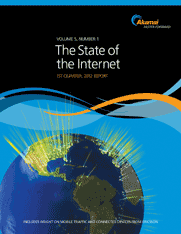Global Broadband is Speeding Up, Says latest “State of the Internet” Report
The broadband revolution is proceeding apace across the globe as internet speed and adoption have increased at faster paces. The Akamai company recently released its First Quarter, 2012 State of the Internet report which discusses important global broadband statistics like internet penetration rates, mobile connection speeds, regional and global connection speeds, and broadband adoption among many others. The report, in addition to providing invaluable insight into global trends in broadband, also underscores the role broadband and mobile technologies can play in the future of development.
Thanks to an ever-increasing demand for connectivity in both developed and emerging economies the world has seen a dramatic rise. Broadband speed has increased to such an extend that Akamai has redefined what it calls “high-broadband.” Previously, any connection at speeds of 2Mbps or higher was defined as broadband, but now Akamai will consider connections of 4Mbps has broadband and connections of 10Mbps has high broadband.
For the first quarter of 2012, the report points out a series of trends:
- A 6 percent global increase in the number of unique IP addresses to over 666 million in between fourth quarter 2011
- A global average of peak connection speed of 13.5 Mbps
- A global average connection speed of 2.6Mbps
- A global average mobile connection speed range between 32.2 Mbps and 2.2 Mbps
- A doubling in global mobile data traffic between the first quarters of 2011 and 2012
- A global increase in adoption of high broadband







































